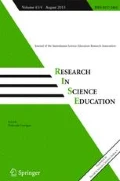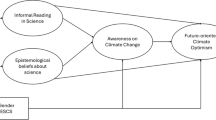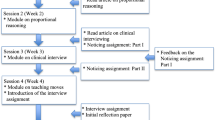Abstract
Overcoming students’ misconceptions may be a challenge when teaching about phenomena such as climate change. Students tend to cite short-term weather effects as evidence to support or refute long-term climate transformations, which displays a fundamental misunderstanding about weather and climate distinctions. Confusion about weather and climate may also reflect student misunderstanding about deep time, a concept that spans several scientific content areas. This study examines the relationships between students’ understanding of deep time and their understandings of the distinctions between weather and climate, as well as how these understandings influence students’ perceptions about the plausibility of human-induced global climate change. Undergraduate students enrolled in an introductory science class on global climate change completed measures of their (a) understanding of distinctions between weather and climate, (b) knowledge of deep time, and (c) plausibility perceptions of human-induced climate change, both at the beginning and end of the course. The study includes comparison groups of similar students enrolled in introductory physical geography classes. Results revealed that greater knowledge of deep time and increased plausibility perceptions of human-induced climate change provide significant explanation of variance in students’ understanding of weather and climate distinctions. Furthermore, students achieve significantly increased understanding of weather and climate, even with brief instruction.

Similar content being viewed by others

References
American Association for the Advancement of Science. (1993). Benchmarks for science literacy. New York: Oxford University Press.
Bostrom, A., Morgan, M. G., Fischhoff, B., & Read, D. (1994). What do people know about global climate change? 1 Mental models. Risk Analysis, 14, 959–970.
Boykoff, M. (2007). From convergence to contention: United States mass media representations of anthropogenic climate change science. Transactions of the Institute of British Geographers, 32, 477–489.
Chi, M. T. H. (2005). Commonsense conceptions of emergent processes: why some misconceptions are robust. The Journal of Learning Sciences, 14, 161–199.
Chinn, C., & Brewer, W. (1993). The role of anomalous data in knowledge acquisition: a theoretical framework and implications for science education. Review of Educational Research, 63, 1–49.
Connell, L., & Keane, M. T. (2004). What plausibly affects plausibility? Concept coherence and distributional word coherence as factors influencing plausibility judgments. Memory & Cognition, 32, 185–197.
Connell, L., & Keane, M. T. (2006). A model of plausibility. Cognitive Science, 30, 95–120.
DeVellis, R. F. (2003). Scale development: Theory and applications (2nd ed.). Newbury Park: Sage.
diSessa, A. A. (1993). Toward an epistemology of physics. Cognition and Instruction, 10, 105–225.
Dodick, J., & Orion, N. (2003a). Cognitive factors affecting student understanding of geologic time. Journal of Research in Science Teaching, 40, 415–442.
Dodick, J., & Orion, N. (2003b). Measuring student understanding of geological time. Science Education, 87, 708–731.
Dole, J., & Sinatra, G. M. (1998). Reconceptualizing change in the cognitive construction of knowledge. Educational Psychologist, 33, 109–128.
Duit, R., Treagust, D. F., & Widodo, A. (2008). Teaching science for conceptual change: Theory and practice. In S. Vosniadou (Ed.), International handbook of research on conceptual change (pp. 629–646). New York: Routledge.
George, D., & Mallery, P. (2003). SPSS for windows step by step: A simple guide and reference. 11.0 update (4th ed.). Boston: Allyn & Bacon.
Gowda, M. V. R., Fox, J. C., & Magelky, R. D. (1997). Students’ understanding of climate change: insights for scientists and educators. Bulletin of the American Meteorological Society, 78, 2232–2240.
Intergovernmental Panel on Climate Change. (2008). Climate change 2007: Synthesis report. Geneva: World Meteorological Organization.
Joyce, C. (2010). U.S. scientists urge action on climate change. National Public Radio. Retrieved from http://www.npr.org/templates/story/story.php?storyId=126985040.
Keller, J. M. (2006). Development of a concept inventory assessing students’ beliefs and reasoning difficulties regarding the greenhouse effect (Doctoral dissertation). Available from Dissertations and Theses database. (UMI No. 3237466)
Libarkin, J. C., Anderson, S. W., Science, J. D., Beilfuss, M., & Boone, W. (2005). Qualitative analysis of college students’ ideas interviews and open-ended questionnaires. Journal of Geoscience Education, 53(1), 17–26.
Mason, L., & Scirica, F. (2006). Prediction of students’ argumentation skills about controversial topics by epistemological understanding. Learning and Instruction, 16(5), 492–509.
Montangero, J. (1996). Understanding changes in time: The development of diachronic thinking in young children. London: Taylor and Francis.
National Academy of Sciences. (2010). Advancing the science of climate change. Washington, D.C.: National Academies Press.
National Climatic Data Center. (2008). Weather/climate events. Retrieved April 21, 2008, from http://www.ncdc.noaa.gov/oa/climateresearch.html.
Neter, J., Wasserman, W., & Kutner, M. H. (1990). Applied linear statistical models (3rd ed.). Boston: Irwin.
Österlind, K. (2005). Concept formation in environmental education: 14-year olds’ work on the intensified greenhouse effect and the depletion of the ozone layer. International Journal of Science Education, 27, 891–908.
Papadimitriou, V. (2004). Prospective primary teachers’ understanding of climate change, greenhouse effect, and ozone layer depletion. Journal of Science Education and Technology, 13, 299–307.
Pintrich, P. R., Marx, R. W., & Boyle, R. B. (1993). Beyond cold conceptual change: the role of motivational beliefs and classroom contextual factors in the process of conceptual change. Review of Educational Research, 63, 167–199.
Posner, G. J., Strike, K. A., Hewson, P. W., & Gertzog, W. A. (1982). Accommodation of a scientific conception: toward a theory of conceptual change. Science Education, 66, 211–227.
Prather, E. (2005). Students’ beliefs about the role of atoms in radioactive decay and half-life. Journal of Geoscience Education, 53, 345–354.
Read, D., Bostrom, A., Morgan, M. G., Fischhoff, B., & Smuts, T. (1994). What do people know about global climate change? 2 Survey studies of educated laypeople. Risk Analysis, 14, 971–982.
Rye, J. A., Rubba, P. A., & Wiesenmayer, R. L. (1997). An investigation of middle school students’ alternative conceptions of global warming. International Journal of Science Education, 19, 527–551.
Sadler, T. D., Chambers, W. F., & Zeidler, D. L. (2004). Student conceptualizations of the nature of science in response to a socioscientific issue. International Journal of Science Education, 26, 387–409.
Tabachnick, B. G., & Fidell, L. S. (1996). Using multivariate statistics (3rd ed.). New York: Harper.
Taylor, A. K., & Kowalski, P. (2004). Naïve psychological science: the prevalence, strength, and sources of misconceptions. The Psychological Record, 54, 15–25.
Trend, R. D. (2001a). Deep time framework: a preliminary study of U.K. primary teachers’ conceptions of geological time and perceptions of geoscience. Journal of Research in Science Teaching, 38, 191–221.
Trend, R. D. (2001b). An investigation into the understanding of geological time among 17-year-old students, with implications for the subject matter knowledge of future teachers. International Research in Geographical and Environmental Education, 10, 298–321.
Vosniadou, S., & Brewer, W. F. (1992). Mental models of the earth: a study of conceptual change in childhood. Cognitive Psychology, 24, 535–585.
Acknowledgements
We thank Janelle Bailey, Jacqueline Cordova, Matthew Lachniet, Louis Nadelson, E. Michael Nussbaum, Gita Taasoobshirazi, and the anonymous reviewers for their helpful feedback during preparation of this article.
Author information
Authors and Affiliations
Corresponding author
Appendices
Appendix A
Distinctions Between Weather and Climate Measure (DWCM)
Read the following statements. Decide if the statement best fits into the category of weather or climate and check the appropriate box.

Appendix B
Plausibility Perceptions Measure (PPM)
Read the following statements. Rate the plausibility on a scale from 1 to 10: 1 being greatly implausible (or even impossible) and 10 being highly plausible. Try to use the full range of numbers in your responses.


Rights and permissions
About this article
Cite this article
Lombardi, D., Sinatra, G.M. College Students’ Perceptions About the Plausibility of Human-Induced Climate Change. Res Sci Educ 42, 201–217 (2012). https://doi.org/10.1007/s11165-010-9196-z
Published:
Issue Date:
DOI: https://doi.org/10.1007/s11165-010-9196-z



